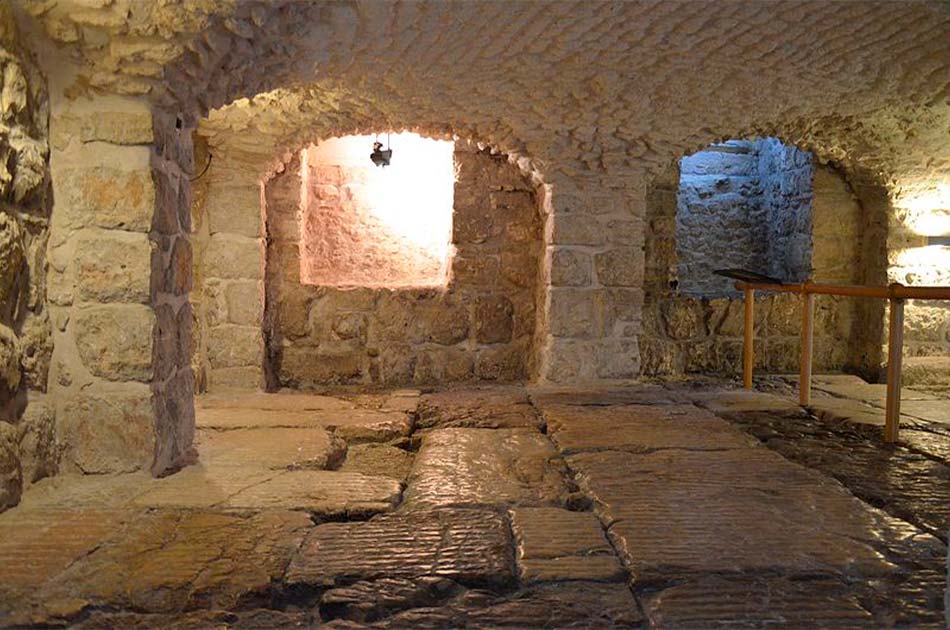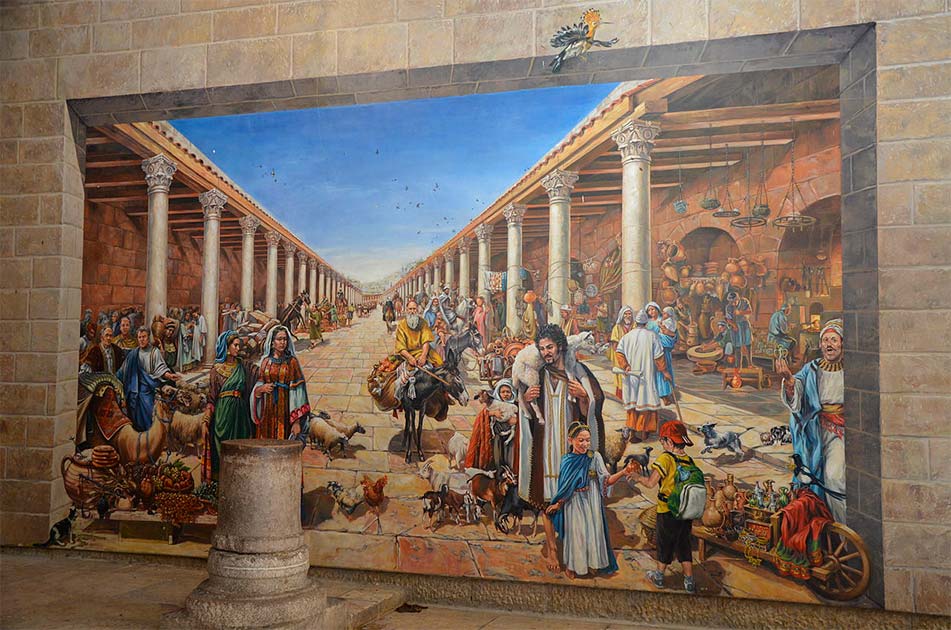70 AD was a terrible year for the Jews of Jerusalem. Half a decade earlier, the new Roman prefect Gessius Florus had asked for a cut of the offerings to the Temple at the heart of the city, and stung Jerusalem into revolt against Rome.
This did not go well. Nero, Emperor of Rome sent one of his most capable generals (and eventual successor) Vespasian to Judea to deal with the rebellion. Vespasian swept across Galilee in the following year and, under the command of his son Titus, Jerusalem was besieged in 70 AD.
After a heroic defense lasting almost five months, Jerusalem eventually fell. What followed next was bloody destruction, with the greater part of the city including the Second Temple being utterly destroyed. The Temple has never been rebuilt.
But what happened next? Well, for the next few decades, nothing at all. But then, out of the ashes, rose Aelia Capitolina.
A City Built on Ruin
Aelia Capitolina was founded in 135 A, 65 years after the victorious Romans had destroyed the city. The name of the settlement was established after a second Jewish revolt, known as the Kitos war, which had erupted in 115 AD and which the Romans took two years to bring under control.
The city was named in honor of Hadrian. His family name was Aelius, and it was combined with the deities of the Capitoline Triad (Jupiter, Minerva, and Juno). This city had the bones of Jerusalem, but was entirely Roman.

On the Temple Mount, a sanctuary to Jupiter was built as were other statues dedicated to Roman deities around the city. This was callous disregard for the citizens of the city, and their Old Testament law about idols, and was intentional by the Romans.
The new city was walled and a large foreign population was introduced, a common tactic among conquering nations to reduce the power bases both of the people introduced, and the people already there. Jews unfortunately were forbidden from the city.
Today, the present walls of the old city of Jerusalem follow the layout of the Roman walls. The new name of the city was used right up until Christianity was accepted as the official religion of the Roman Empire in the 4th century.
As a city, Jerusalem had faced extensive rebuilds under King Herod. However the Romans had been thorough, the destruction they wrought with the fall of the city in 70 AD left Jerusalem partially abandoned.
Hadrian decided that he was going to rebuild the city as a Roman Colony that he would use as a base for his legionaries. It was the location and the existing infrastructure that was important to him, and his move to expel the Jewish population was an attempt to stop the rebellions.
Around this time there was another Jewish rebellion, known as the Bar Kokhba revolt, which started in 132 AD and led to four years of conflict. It is hard to say whether Hadrian’s anti-Jewish decrees preceded or followed this but what is clear is that the war that followed was devastating.
The traditional view is that fact that the Bar Kokhba revolt took so long to suppress enraged Hadrian and thus he sought to eradicate the Jewish religion in Jerusalem, which kept throwing off the yoke of Roman Imperial rule. He did this by forbidding circumcision and expelling known Jews from the city. He even renamed the Judean (“Iudaea”) Province to “Syria Palaestina” so that he could disregard the name of Judea.
In this context, Jerusalem was renamed Aelia Capitolina and rebuilt in the style of the original Hippodamian (grid) plan, although with Roman touches. Jews were forbidden on pain of death excluding one day of the year, the fast day of Tisha B’Av.
It has been suggested that these measures secularised the city. Archaeology and historical sources suggest that the rebuilt city became inhabited mostly by veterans of the Roman military as well as immigrants from the western parts of the Empire. Jerusalem, the Jewish capital, was to be no more: this was Aelia Capitolina, and this city was Roman.
Byzantines
Nor was this quickly changed, as you would think. The banning of the Jews from the city was maintained for nearly 600 years, only being lifted in the 7th century.
Christians had been granted an exemption during the 4th century when Constantine I, upon his own conversion, ordered the construction of Christian holy sites in the city. One of these buildings was the Church of the Holy Sepulchre.

Burial remains that have been found show that during the Byzantine period which came later, the burials were exclusively Christian. This perhaps indicates that the population of Jerusalem, at this time, may have been solely Christian.
In the 5th century, the Eastern Roman Empire which was based in Constantinople controlled the city. However, things would suddenly change when the Sassanid king Khosrau II, striking from what is now Iran in the 7th century, advanced through Syria and attacked Jerusalem. In this he had the help of the Jews who were rising against the Byzantines at this time.
- Decadent Roman Party Town: The Lost City of Baiae
- King Uzziah’s Earthquake: Evidence from Archaeology
In 614 AD after a relentless siege of 21 days, Jerusalem was captured. Chronicles from the time claim that the Sassanid forces took a leaf from the Roman playbook and slaughtered the inhabitants and destroyed the place, including the monuments of the Christians and the Church of the Holy Sepulchre. It remained in Sassanid hands for fifteen years until the Byzantine Emperor Heraclius retook it in 629.
The writing was on the wall for Byzantine Jerusalem though. It was conquered by the Arab armies of Umar ibn al-Khattab a decade later in 638 AD. This finally removed the restrictions on the Jews living in the city. The Temple Mount then became known as the City of the Temple or Madinat bayt al-Maqdis, and the surrounding city became known as Iliya, a reflection of the Roman name of Aelia Capitolina.
A Lost Roman City
So, we have a city built upon ruins that was itself completely destroyed after 500 years, a lost city on a lost city. However some evidence can be found in the archaeology for what Aelia Capitolina was like.
Originally the city was without walls, and protected by a garrison of the Roman Tenth Legion. These soldiers at Jerusalem were the ones specifically tasked with keeping the Jews from returning to the city.
The urban plan of the city was similar to that of a typical model Roman town. There were main thoroughfares that crisscrossed creating an urban grid. The urban grid was based on the central north-south road and the central east-west road.

The main road running from east-west was blocked by Temple Mount, a feature of the landscape which could not simply be removed. Thus a secondary road had to be created to zigzag around the temple. The old street pattern was preserved in the old city of Jerusalem which can still be seen today. It was likely that the thoroughfare was flanked by columns and shops.
The main forum was placed at a junction between the main road and the east-west road. In this forum, Hadrian built a large temple to Venus which was to be used later for the Church of the Holy Sepulchre.
Much of the boundary walls for this temple have been found in archaeological investigations. In addition to this, Hadrian built a triple-arched gateway as an entrance to the Eastern Forum. It has been traditionally thought that this was the entrance to the Antonia Fortress, which was alleged to be the location of Jesus’s trial. This is sadly lost, demolished in the 19th century to create a mosque.
Looking back, Aelia Capitolina represents an underappreciated aspect of Jerusalem’s history. It was a city born out of war and spite as the Romans attempted to create a military site on a city that was held in such high esteem by a rival religion.
It is clear from the deliberate idols placed there that the Roman population sought to send a message to the rising tide of Christianity. However, this was a trend that would follow the city into the future as it continued to be a hotbed of war and strife. Despite its religious significance, the violent history of Aelia Capitolina needs attention as well.
Top Image: Map of Aelia Capitolina from a 6th century Byzantine church. For five centuries the Jews were expelled from Jerusalem by the Romans. Source: Unknown Author / Public Domain.
By Kurt Readman